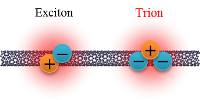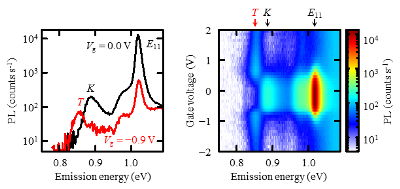Research:Gate-voltage induced trions in suspended carbon nanotubes
The quasi-one-dimensional geometry of single-walled carbon nanotubes results in enhanced Coulombic effects because of limited screening. The strong attractive force between carriers generates tightly bound excitons and trions (charged excitons) which are stable even at room temperature. In the case of excitons, various interesting phenomena in nanotubes have been observed such as exciton-exciton annihilation, spontaneous exciton dissociation, and Stark effect, which may lead to novel nanoscale detectors and emitters. In comparison, trions provide additional degrees of freedom for manipulating the optical properties of nanotubes as they possess both charge and spin, and consequently they have received considerable attention for their potential applications in spintronics and quantum information processing.

Carrier doping is necessary to generate trions, and therefore we have fabricated suspended carbon nanotube field-effect transistors. Carriers can be induced gy applying gate voltages, and we have performed photoluminescence measurements.
The figures below show gate-voltage dependence of photoluminescence. When a gate voltage is applied, exciton peaks (E11 and K) show quenching, and a new peak (T) that is redshifted from E11 is observed. Such a behavior indicates that electrostatic carrier doping gives rise to the new peak, and we therefore assign the gate-induced peak (T) to trion emission.

In addition, we find that the energy splitting between E11 and T peaks in suspended nanotubes is significantly larger compared to micelle-wrapped nanotubes. This result indicates that trion binding energies in suspended nanotubes are larger than those in micelle-wrapped nanotubes, and the difference is attributed to the reduced dielectric screening in suspended tubes.
To learn more about this work, please refer to:
Gate-voltage induced trions in suspended carbon nanotubes
Phys. Rev. B
93, 041402(R) (2016).
![]()